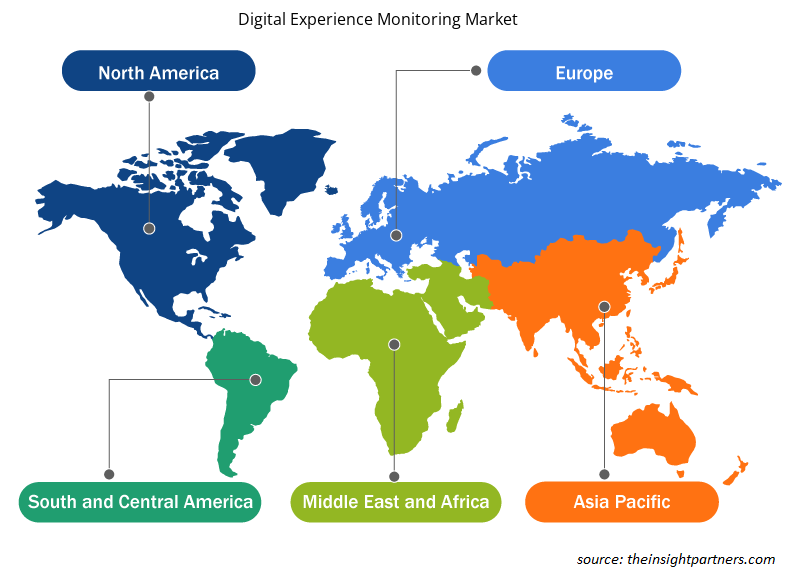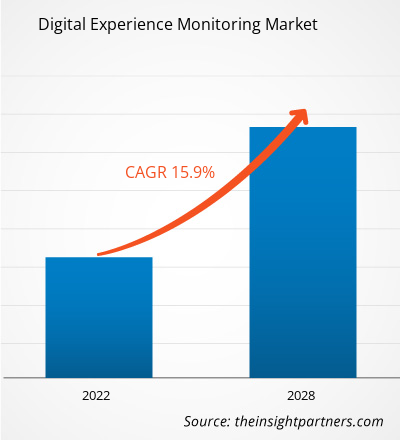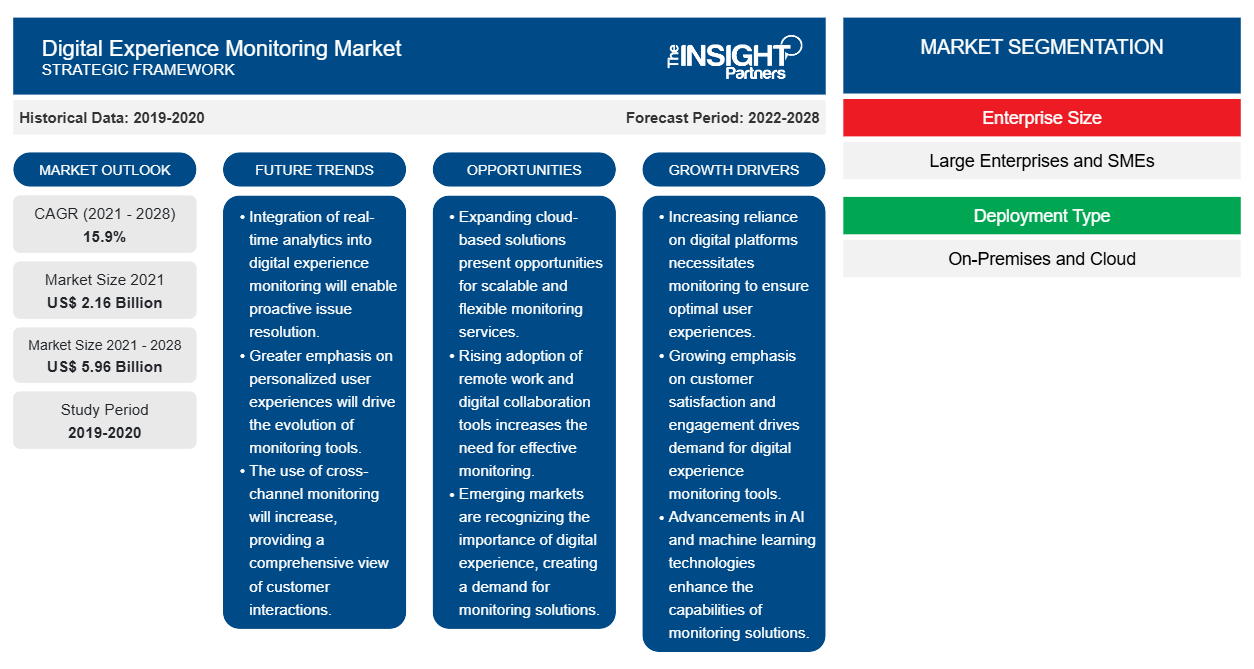من المتوقع أن ينمو حجم سوق مراقبة التجربة الرقمية من 2،156.71 مليون دولار أمريكي في عام 2021 إلى 5،960.87 مليون دولار أمريكي بحلول عام 2028. ومن المتوقع أن ينمو حجم سوق مراقبة التجربة الرقمية بمعدل نمو سنوي مركب قدره 15.9٪ من عام 2022 إلى عام 2028.
إن مراقبة التجربة الرقمية (DEM) هي تقنية جديدة تبحث عنها الشركات كطريقة لتبسيط مخاوف أداء المستخدم مع اكتساب نظرة ثاقبة لمجموعة من تقنيات الشبكات من خلال حل واحد. إن تطور مراقبة أداء التطبيق (APM) ومراقبة تجربة المستخدم النهائي (EUEM) إلى حل شامل يقيم فعالية تطبيقات وخدمات المؤسسة هو مراقبة التجربة الرقمية (DEM). إن مراقبة التجربة الرقمية (DEM) هي حل مراقبة في الوقت الفعلي يساعد فرق عمليات تكنولوجيا المعلومات في حل مخاوف المستخدم على الفور مع ضمان عدم إزعاج الشبكة. يمكن استكمال تقنيات مراقبة أداء التطبيق (APM) ومراقبة أداء الشبكة والتشخيص (NPMD) الحالية بحلول مراقبة التجربة الرقمية (DEM). عند استخدامها معًا، فإنها توفر رؤية شاملة، مع توفير مراقبة تجربة المستخدم نظرة ثاقبة لتجربة المستخدم. هذه هي التجارب التي لها التأثير الأكثر مباشرة على نتائج الشركة. DEM هي أداة مراقبة في الوقت الفعلي تساعد "الآلة" الخاصة بشركتك على العمل بسلاسة من خلال اكتشاف نقاط الضعف التي تسبب توقفًا أو اضطرابات في تجربة المستخدم، مثل أوقات تحميل الصفحة السيئة، وتحديد السبب الأساسي للأداء. يراقب برنامج DEM سلوك المستخدم وحركة المرور والعوامل الإضافية لمساعدة الشركات على فهم قابلية استخدام المنتج والأداء. تدمج منتجات DEM حركة المرور النشطة أو المحاكاة ومراقبة المستخدم الحقيقي لتحليل الأداء النظري وتجربة المستخدم الحقيقي. توفر هذه الأدوات أدوات تحليلية لفحص وتحسين أداء التطبيق والموقع. كما تساعد الشركات على فهم كيفية تنقل الزوار عبر موقعها واكتشاف الأماكن التي يبدو أن تجربة المستخدم النهائي تعاني فيها.
إن فحص بيانات الأداء عبر الأجهزة والتطبيقات والبنية الأساسية والخدمات لفهم كيفية تأثير تفاعلات المستخدمين النهائيين مع التكنولوجيا على جودة تجربتهم الرقمية يُعرف باسم DEM. قد تتبع تكنولوجيا المعلومات وتقيم العديد من المعلمات التي تؤثر على المستخدمين، بما في ذلك وحدة المعالجة المركزية والذاكرة واستخدام الأجهزة والزمن الكامن وأداء البرامج والمزيد، باستخدام مراقبة التجربة الرقمية. قد تساعد هذه القياسات، التي يتم جمعها باستمرار من نقطة النهاية وإقرانها بالتحليل المعرفي والأتمتة، تكنولوجيا المعلومات في تشخيص المشكلات ومعالجتها وحتى التنبؤ بها على الفور دون علم المستخدم. يمكن أن تشير الملاحظات والآراء أيضًا إلى العناصر التي لا تستطيع إحصاءات نقطة النهاية التقاطها. تتجاوز حلول مراقبة التجربة الرقمية مراقبة أداء الشبكة والتطبيق النموذجية للكشف عن مشكلات الشبكة، والتي قد تؤثر على أداء الخدمة المستندة إلى السحابة. يؤثر هذا العامل على نمو سوق مراقبة التجربة الرقمية .
قم بتخصيص هذا التقرير ليناسب متطلباتك
ستحصل على تخصيص لأي تقرير - مجانًا - بما في ذلك أجزاء من هذا التقرير، أو تحليل على مستوى الدولة، وحزمة بيانات Excel، بالإضافة إلى الاستفادة من العروض والخصومات الرائعة للشركات الناشئة والجامعات
- احصل على أهم اتجاهات السوق الرئيسية لهذا التقرير.ستتضمن هذه العينة المجانية تحليلاً للبيانات، بدءًا من اتجاهات السوق وحتى التقديرات والتوقعات.
تأثير جائحة كوفيد-19 على سوق مراقبة التجربة الرقمية
مع ظهور جائحة كوفيد-19، توقف قطاع الطيران بأكمله بشكل غير مجدول. أبلغت تركيا وإيران وجنوب إفريقيا والعراق وإسرائيل والمملكة العربية السعودية والإمارات العربية المتحدة عن عدد كبير من حالات الإصابة المؤكدة والوفيات بكوفيد-19. يتألف سوق مراقبة التجربة الرقمية من اقتصادات رئيسية، مثل الإمارات العربية المتحدة والمملكة العربية السعودية، وهما من المزودين المحتملين في صناعة مراقبة التجربة الرقمية بسبب الوجود الضخم لقاعدة عملاء متنوعة. قبل الوباء، كانت دول الخليج على وشك تبني تقنيات رقمية تحويلية في مختلف القطاعات الرأسية لتحسين الظروف الاجتماعية والاقتصادية للدول. ومع ذلك، بسبب تفشي كوفيد-19، أدى تنفيذ تدابير صارمة مثل إغلاق المصانع وإغلاق الأعمال وقيود السفر إلى تفاقم المشاكل الاقتصادية للدول، مثل منطقة الشرق الأوسط وأفريقيا. وبالتالي، فإن الحالة الاقتصادية لمنطقة الشرق الأوسط وأفريقيا وتأثير جائحة كوفيد-19 على نمو مختلف الصناعات في المنطقة أثرت بشكل طفيف على نمو سوق مراقبة التجربة الرقمية في عام 2020.
رؤى السوق حول مراقبة التجربة الرقمية
لقد تم تعزيز نظام ملاحظات العملاء الذي يعد بالغ الأهمية لأي صناعة مراقبة تجربة رقمية وظيفية ومربحة بفضل التحسينات التكنولوجية في سوق مراقبة التجربة الرقمية. على سبيل المثال، تنفذ الشركات نظام ملاحظات عبر الإنترنت باستخدام نظام إدارة علاقات العملاء المتطور (CRM). ونتيجة لذلك، تساعد مدخلات العميل بشكل مباشر في إجراء تعديلات في الوقت الفعلي وتحديث برنامج الشركة لإجراء تقييم في الوقت الفعلي للجودة وتعديلها أو تغييرها حسب الحاجة. يجب على أي شركة تشهد تحولًا رقميًا تنفيذ أنظمة مراقبة التجربة. إن تبسيط الإجراءات الرقمية المشاركة في إدارة الشركة يضع أساسًا قويًا للتغييرات المستقبلية في النظام أو الابتكار المستمر. هذا هو ما يدفع سوق مراقبة التجربة الرقمية.
رؤى السوق بناءً على حجم المؤسسة
تحليل سوق مراقبة التجربة الرقمية حسب حجم المؤسسة، تم تقسيم السوق إلى شركات كبيرة وصغيرة الحجم. في عام 2021، استحوذت شريحة الشركات الكبيرة على حصة أكبر في سوق مراقبة التجربة الرقمية.
رؤى السوق المستندة إلى نوع النشر
تحليل سوق مراقبة التجربة الرقمية حسب نوع النشر، تم تقسيم السوق إلى محلي وسحابي. في عام 2021، استحوذ قطاع السحابة على حصة أكبر في سوق مراقبة التجربة الرقمية.
يتبنى اللاعبون استراتيجيات، مثل عمليات الدمج والاستحواذ ومبادرات السوق، للحفاظ على مواقعهم في السوق. وفيما يلي قائمة ببعض التطورات التي قام بها اللاعبون الرئيسيون في السوق:
- في عام 2022، أعلنت BMC عن قدرات وتكاملات جديدة عبر مجموعتي BMC AMI (ذكاء الحاسوب المركزي الآلي) وBMC Compuware. تساعد الابتكارات العملاء على تحسين جودة الخدمة وتسريع تسليم البرامج من خلال توفير رؤية أكبر للبيانات ورؤى قائمة على السياق عبر بيئات تكنولوجيا المعلومات الخاصة بهم.
- في عام 2021، استحوذت شركة Broadcom Inc. على AppNeta لتعزيز مراقبة أداء الشبكة عبر الإنترنت والتطبيقات الهجينة المستندة إلى السحابة. من خلال الجمع بين الرؤية الشاملة التي توفرها AppNeta وقدرات البنية الأساسية وAIOps الحائزة على جوائز والمثبتة من Broadcom، ستتمكن أكبر الشركات في العالم التي تدير أكثر الشبكات تعقيدًا الآن من الوصول إلى مصدر واحد للحقيقة لدعم رحلتها السحابية.
رؤى إقليمية حول سوق مراقبة التجربة الرقمية
لقد قام المحللون في Insight Partners بشرح الاتجاهات والعوامل الإقليمية المؤثرة على سوق مراقبة التجربة الرقمية طوال فترة التوقعات بشكل شامل. يناقش هذا القسم أيضًا قطاعات سوق مراقبة التجربة الرقمية والجغرافيا في جميع أنحاء أمريكا الشمالية وأوروبا ومنطقة آسيا والمحيط الهادئ والشرق الأوسط وأفريقيا وأمريكا الجنوبية والوسطى.

- احصل على البيانات الإقليمية المحددة لسوق مراقبة التجربة الرقمية
نطاق تقرير سوق مراقبة التجربة الرقمية
| سمة التقرير | تفاصيل |
|---|---|
| حجم السوق في عام 2021 | 2.16 مليار دولار أمريكي |
| حجم السوق بحلول عام 2028 | 5.96 مليار دولار أمريكي |
| معدل النمو السنوي المركب العالمي (2021 - 2028) | 15.9% |
| البيانات التاريخية | 2019-2020 |
| فترة التنبؤ | 2022-2028 |
| القطاعات المغطاة | حسب حجم المؤسسة
|
| المناطق والدول المغطاة | أمريكا الشمالية
|
| قادة السوق وملفات تعريف الشركات الرئيسية |
|
كثافة اللاعبين في سوق مراقبة التجربة الرقمية: فهم تأثيرها على ديناميكيات الأعمال
يشهد سوق مراقبة التجربة الرقمية نموًا سريعًا، مدفوعًا بالطلب المتزايد من المستخدم النهائي بسبب عوامل مثل تفضيلات المستهلك المتطورة والتقدم التكنولوجي والوعي الأكبر بفوائد المنتج. ومع ارتفاع الطلب، تعمل الشركات على توسيع عروضها والابتكار لتلبية احتياجات المستهلكين والاستفادة من الاتجاهات الناشئة، مما يؤدي إلى زيادة نمو السوق.
تشير كثافة اللاعبين في السوق إلى توزيع الشركات أو المؤسسات العاملة في سوق أو صناعة معينة. وهي تشير إلى عدد المنافسين (اللاعبين في السوق) الموجودين في مساحة سوق معينة نسبة إلى حجمها أو قيمتها السوقية الإجمالية.
الشركات الرئيسية العاملة في سوق مراقبة التجربة الرقمية هي:
- شركة آب داينامكس المحدودة
- شركة BMC للبرمجيات
- شركة برودكوم
- شركة كاتش بوينت سيستمز
- شركة ديناتريس المحدودة
إخلاء المسؤولية : الشركات المذكورة أعلاه ليست مرتبة بأي ترتيب معين.

- احصل على نظرة عامة على أهم اللاعبين الرئيسيين في سوق مراقبة التجربة الرقمية
ملفات تعريف الشركات في تقرير سوق مراقبة التجربة الرقمية
- شركة BMC للبرمجيات
- شركة برودكوم
- شركة كنترول أب للتكنولوجيا المحدودة
- شركة ليكسايد للبرمجيات، ذ.م.م
- شركة اتيرنتي المحدودة
- نيكستينك جنوب أفريقيا
- شركة آب داينامكس المحدودة
- شركة كاتش بوينت سيستمز
- شركة ديناتريس المحدودة
- شركة آي بي إم
- التركيز الدقيق
- شركة أوراكل
- شركة ريفربد للتكنولوجيا
- ساب اس اي
- التحليل التاريخي (سنتان)، سنة الأساس، التوقعات (7 سنوات) مع معدل النمو السنوي المركب
- تحليل PEST و SWOT
- حجم السوق والقيمة / الحجم - عالمي، إقليمي، بلد
- الصناعة والمنافسة
- مجموعة بيانات إكسل
التقارير الحديثة
تقارير ذات صلة
شهادات العملاء
سبب الشراء
- اتخاذ قرارات مدروسة
- فهم ديناميكيات السوق
- تحليل المنافسة
- رؤى العملاء
- توقعات السوق
- تخفيف المخاطر
- التخطيط الاستراتيجي
- مبررات الاستثمار
- تحديد الأسواق الناشئة
- تحسين استراتيجيات التسويق
- تعزيز الكفاءة التشغيلية
- مواكبة التوجهات التنظيمية





















 احصل على عينة مجانية ل - سوق مراقبة التجربة الرقمية
احصل على عينة مجانية ل - سوق مراقبة التجربة الرقمية